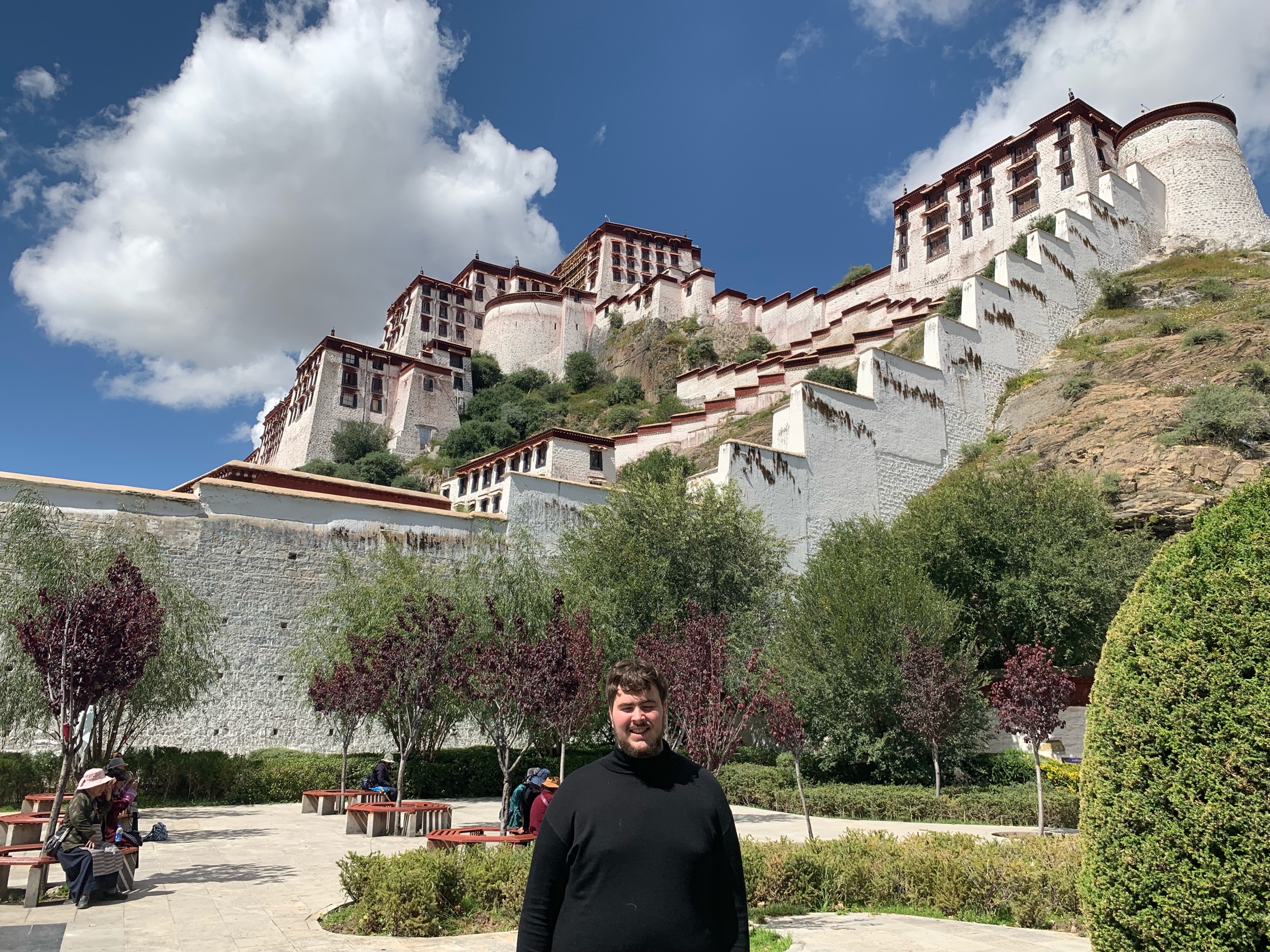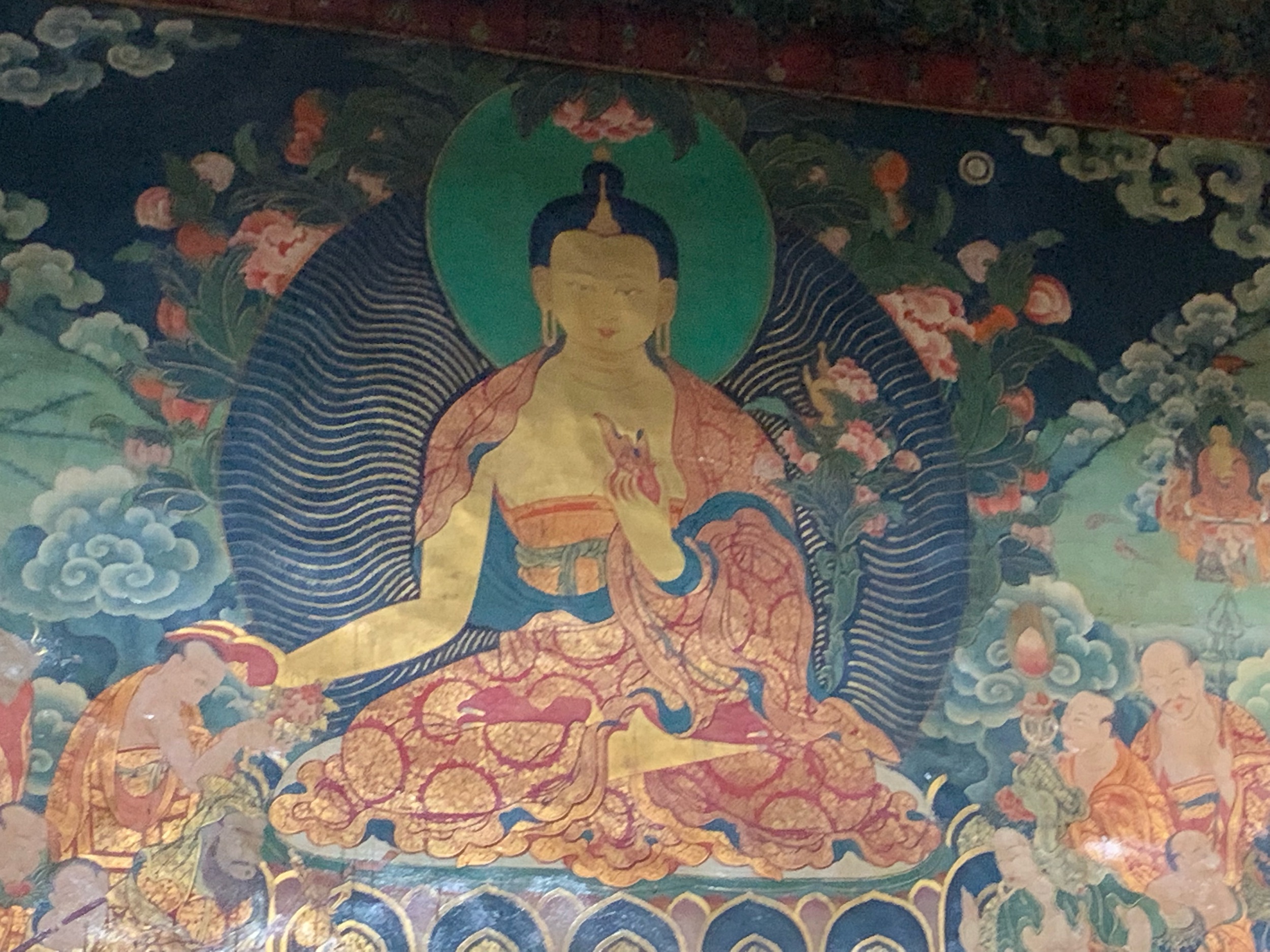9-30-19 - Lhasa - Jokhang Temple, Potala Palace & armed military
/Day 106. Kyle, Leanne & John joint blog.
After a quick buffet breakfast, we are ready to see the wonders of Tibet. With two UNESCO sites planned for today, we are predicting today will be a very fulfilling day indeed. First stop is 8th century Jokhang Temple which does not disappoint.
The Jokhang Temple is a major pilgrimage site for Tibetan Buddhists. It is a pilgrimage the Tibetan faithful are expected to do at least once in their lives — even those from the faraway mountain villages. More than 50 years ago our guide Bemba’s own parents made the pilgrimage to Lhasa from the mountains; a journey of over 1500 kilometers which took over one year of walking to arrive at this very site to pay respect to Buddha. His parents ended up staying in Lhasa where he was born.
The temple is in the main central square, Bakhour Square, where we come across a river of Tibetan people, hundreds in fact, many in traditional long skirts walking, chanting, chatting and spinning their prayer wheels. It was like nothing we have ever witnessed before. In front of the Temple, there was a constant wave of people competing a circle around it with prayer wheels, a wheel with scripture in it, spun around to show the cycle of reincarnation. There was so many people young and old, all walking in this circle with prayer wheels and reading scripture and chanting.
We make it through the wall of people, and see the next stunning thing, around two hundred people are doing a traditional Tibet praying ritual called prostrating, where they bow, kneel, lay down, make a circle with their arms and repeat. What was really stunning was that there was elderly people, doing a constant stream of these physically strenuous prayers. Closer to the temple there are approximately 80 people just praying with yoga mats and hand slides. Up and down, hand slide forward, bow and chant. Bemba tells us that many people will do over 500,000 prostrating prayer rituals in their lifetime. Just getting to the temple, we’re overwhelmed by these deep and serious displays of pure faith we are all witnessing.
We make it into the temple itself and are stunned. The temple is traditional Tibetan Buddhist fashioned in the traditional style with red and white clay. The temple has more than 100 chapels rooms and contains a statue that was blessed by the original Buddha almost 2,000 years ago. There are so many carved engravings along the walls depicting different scenes from Buddhist legends.
We walk into a room with 8 different gold Buddha statues and a wax candle of light in the middle. We walk out stunned by the absolute beauty hidden in this small room the size of a janitor’s closet. We then learn from our guide that there are 100 of these rooms all with different statues of the Buddha and his disciples. We then see a huge gold mandala depicting the wonders of heaven / nirvana compared to the world. We then see one of the coolest things we’ve come across which is a statue of Buddha that was blessed by the Buddha himself. Our guide says they have records that it did originate from India during the time of the Buddha’s lifetime. Wow! We see so many cool Buddhist artifacts and drawings.
What surprised us was the overwhelming faith of the people on display unlike so many churches in Europe today which are more of a landmark than a pace of worship. The Jokhang temple was packed full of people who had made pilgrimage to Lhasa to pray at this temple. We were only one of literally a handful of people there as a tourist. John buys a traditional prayer wheel from the temple.
After experiencing the Temple, we walk around Barkhor market which is right off the square. We see the locals selling various foods and day-to-day items. While walking, we almost get mowed down by a brigade of Chinese soldiers marching in formation with machine guns and riot gear. We have to use one hand to keep our hand from instinctively pulling out our iPhone and snapping pictures away. The Chinese look like they would be happy to find any reason to employ their trained military tactics on poor unsuspecting iPhone tourists.
During our hour walk, we see numerous brigades of Chinese soldiers sporting their serious heat (also known as weapons). Machine guns, riot gear and even mini-tanks. The soldiers conduct a variety of marching drills in the lively square in front of the historic temple. The square was the site of past protests against Chinese rule so with the 70th anniversary tomorrow, the Chinese are apparently not taking any chances.
After the lunch at the Snowland restaurant and a failed attempt at buying souvenirs, we head off to another UNESCO site, the Potala palace. It was built as the winter palace for the 5th Dalai Lama and his successors, on top of the palace of the great Tibetan King Songtsen Gampo in 637. It is enormous in size with over 1,000 rooms, 10,000 shrines, and 200,000 statues and it is built on top of a hill so it can be seen from anywhere in the city. It is built high into a mountain and it’s quite the site with its whitewashed walls and brown and red accents. It often listed one of the top 10 most impressive palaces in the world.
The 350 steps and many ramps up in the high altitude with the afternoon hot sun felt like 3,000 steps. A few grumbles could be heard in our tired group. Until in front of us we notice a disabled young woman determined to make every step up to the top on her own with the help of her braces and crutches. Watching her persevere gave us renewed sense of just how lucky we are to be there and healthy enough to walk up too. We are all still feeling the altitude and when we finally make it to the top, we have to stop for several minutes to catch our breath. Winded and lightheaded, we finally make it to the Palace entrance.
We start in the museum which gives the Tibetan history, with a unique Chinese twist. It is based around highlighting the various interactions with Tibet as justification of its annexation. Inside the palace we see the many rooms for the Dalai Lama and his family to stay in. The whole time we are in the towering white palace (Dalai lama’s residence), there is a sort of unspoken sadness there. The Dalai Lama was forced to flee from Tibet to India in 1959 and has lived in exile there ever since. The rooms the Dalai Lama lived in before 1959 sit with his personal effects gone and the remaining artifacts preserved with the knowledge that he will never return to Tibet and his former home. There were illustrious items of worship and Buddha statues too many to count.
After our stunning visit of the Potala Palace, on our way out, John gets asked to take a photo with a group of 7 Tibetan guys. Kyle jokes with John than the group asked him if John played in the NBA. American are a rare sighting so far in Tibet as we have not seen any other Americans or even “westerners” for that fact. Add in that we are tall Americans in Tibet and it is the perfect recipe for having the Tibetan paparazzi snapping phots of us. What an experience!
We go back to the hotel to rest exhausted as we are still battling the altitude and colds. Some of us later head out to the Dunya Restaurant again to enjoy some western comfort because when you have a hit, you roll with it and Dunya is a hit.















































